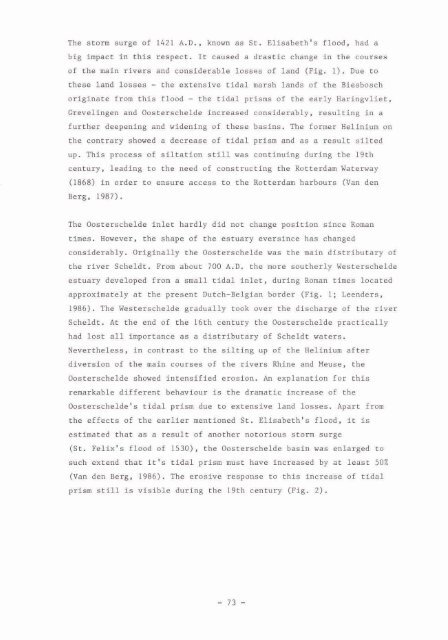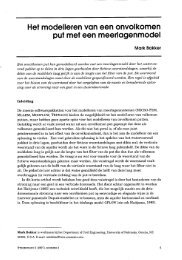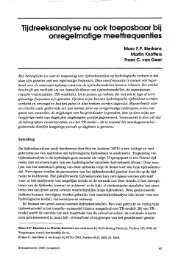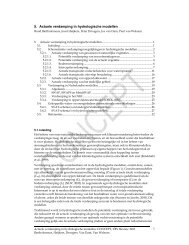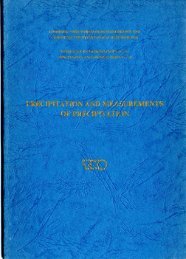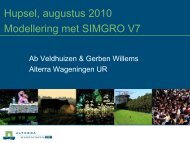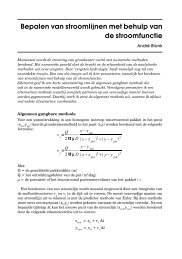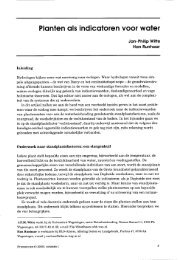Hydro-ecological relations in the Delta Waters
Hydro-ecological relations in the Delta Waters
Hydro-ecological relations in the Delta Waters
Create successful ePaper yourself
Turn your PDF publications into a flip-book with our unique Google optimized e-Paper software.
The storm surke of L&Z1 A.D., knorm as St. ELisabeth's flood, had a<br />
big impact <strong>in</strong> this respect. It caused a drastic change <strong>in</strong> <strong>the</strong> courses<br />
of <strong>the</strong> =<strong>in</strong> rivers and conaiderable losses of laud (Rig. 1). Due to<br />
<strong>the</strong>se land losses - <strong>the</strong> extensive tidal marsh lands of <strong>the</strong> Biesllosch<br />
orig<strong>in</strong>ate from this flood - <strong>the</strong> tidal prisms of <strong>the</strong> early Har<strong>in</strong>gvliet.<br />
erevel<strong>in</strong>geu and Oosrerschelde <strong>in</strong>creased considerably, result<strong>in</strong>g <strong>in</strong> a<br />
fur<strong>the</strong>r deepeniag and widen<strong>in</strong>g of <strong>the</strong>se bas<strong>in</strong>s. The former Eel<strong>in</strong>iua on<br />
<strong>the</strong> contrary showed a decrease of tidal prism and as a result silted<br />
up. This pzocesa of siltation still was cont<strong>in</strong>u<strong>in</strong>g dur<strong>in</strong>g <strong>the</strong> 19th<br />
century, lead* to <strong>the</strong> need of coustmct<strong>in</strong>g <strong>the</strong> Botterdam Waremay<br />
(1868) fm order to ensure aecess to <strong>the</strong> Botterdam harbours (Van den<br />
Berg. 1987).<br />
The Qosterschelde <strong>in</strong>Let hardly did not change position s<strong>in</strong>ce Roman<br />
times. Bowever, <strong>the</strong> shape oE tbe estuary ewers<strong>in</strong>ce has changed<br />
considPrably. Orig<strong>in</strong>ally <strong>the</strong> Oosterschelde was <strong>the</strong> ma<strong>in</strong> distributary of;<br />
<strong>the</strong> river Skheldt. From about 700 &.D. <strong>the</strong> mere sou<strong>the</strong>rly Westerschelde<br />
estuary developed from a small tidal <strong>in</strong>let, dur<strong>in</strong>g Rman times located<br />
approximately at <strong>the</strong> present Dutch-Belgian border (Rig. 1; benders.<br />
19861. The Westet~chelde gradually took over <strong>the</strong> discharge of <strong>the</strong> river<br />
Gcheldt. At <strong>the</strong> end of <strong>the</strong> 16th century <strong>the</strong> Oosterschelde practically<br />
had lost all importance as a distributary of Scheldt waters.<br />
Rever<strong>the</strong>less, <strong>in</strong> contrast to <strong>the</strong> silt<strong>in</strong>g up of <strong>the</strong> Hel<strong>in</strong>iua after<br />
diparsim of <strong>the</strong> mH<strong>in</strong> courses of <strong>the</strong> rivers Rh<strong>in</strong>e and Pleuse, <strong>the</strong><br />
Oostersmhelde showed <strong>in</strong>tensified erosion. An explanation for this<br />
renarkable different behaviour Q <strong>the</strong> dramatie <strong>in</strong>crease of <strong>the</strong><br />
Oostersehelde's tidal prism due to extensive lwd losses. Apart from<br />
<strong>the</strong> effeers of <strong>the</strong> earlier mentioned St. Wsabeth's flood. it 1s<br />
estimated that as a result of ano<strong>the</strong>r notorious storm surge<br />
(St. Pelix's flood of 1530). <strong>the</strong> Ooseerschelde bas<strong>in</strong> was enlarsd to<br />
such extend that it's tidal prism must have <strong>in</strong>creased by at least 50%<br />
(Van den Berg, 1986). The erosive respouse to this <strong>in</strong>czease of tidal<br />
prism still is visible dur<strong>in</strong>g <strong>the</strong> 19th century CFig. 2).


